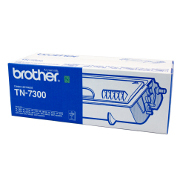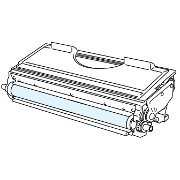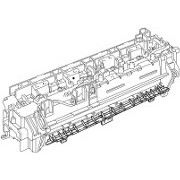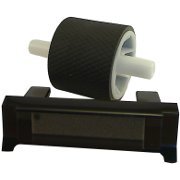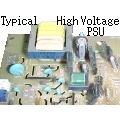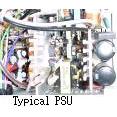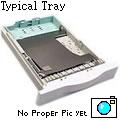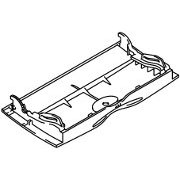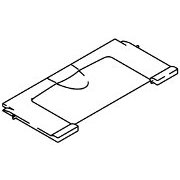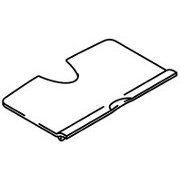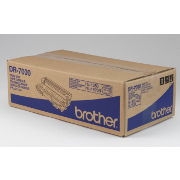Brother Original Toners
Fuser
Spares

Brother HL-1850 and HL-1870N
A4 mono laser printers with a throughput of up to 18 pages per minute. Duplex and a basic but user-friendly LCD display panel are provided as standard.
These printers feature
- A multi-purpose tray for up to 100 sheets,
- An auto-duplex unit,
- Both USB and Parallel Interfaces.
- Optional Ethernet
- Optional extra tray
- Expandable memory
Other features include the ability to print secure documents, although with just +/- keys to select the password it's probably not much used.
- HL-1850 comes with 16MB RAM expandable to 144MB and doesn't have networking provided
- HL-1870N has 32MB RAM expandable to 144MB and has an Ethernet print server.
The HL-1850 and 1870N are successors to the HL-1650 and HL-1670N which had been launched in 2001. The HL1800 series printers launched in 2002 are just a bit faster but have significantly more base memory. The extra memory means that the printer is likely to cope with today's web-pages and PDF's without needing extra memory.
The HL-1850 and HL-1870N no longer made although they may be available from brokers and refurbishers.
Original toner is not cheap but readily available as a refill, as are refurbished drums. One reason to like these printers is the inclusion of bar-code printing.
In conclusion if all you want is an office printer for text applications the HL-1850 will still do a good job.
Control:
Single line 16 character LCD with a coloured back light. Interactive help (via CD on-line support, using on-screen guidelines and moving pictures) LCD display and a set of keys as follows
| Key | Function | |
| 1 | Go | Exit from the Control panel menu, Reprint settings and Error messages. Pause / Continue printing. |
| 2 | Job Cancel | Stop and cancel the printer operation in progress. |
| 3 | Reprint | Select the Reprint menu. |
| 4 | + / - | Move forward and backward through Menus. Move forward and backward through selectable options. Set numbers |
| 5 | Set | Select the Control panel menu. Set the selected menus and settings. |
| 6 | Back | Go back one level in the menu structure. |
The printer can store password protected data until it gets a username and password. To set numbers use the +/- buttons.
The LCD is a one line 16 digit device so it is a bit limited but it does have a coloured back light:
• Green is Warming up, Ready to Print or actually printing
• Orange is for setting options or paused
• Red indicates a problem.
The user manual gives details on how to use the control panel.
The service manual gives information about the inspection mode, professional menu mode and service menu mode which prints test pages etc. These are entered by turning the printer on whilst holding various switches. The service menu is needed to reset consumable counts.
To print a configuration page press the "set " switch three times. This gives the page counter and drum life. Some of the values print in hexadecimal.
The drum count can be cleared with the front cover open (as though the drum had been changed) and pressing go continually until the message ">>>> DRUM CLEAR" appears on the LCD display.
Duty Cycle:
MTBF 4,000 hours, MTTR Average 30 minutes. Brother reckon the periodic maintenance parts (paper feed Kit and printer control boards) have an MTTR of 5 minutes.
Print Speed:
Up to 18ppm for single sided.
Up to 4.25 sheets per minute for duplex print - 8.5 pages per minute. (Printers are often slower in duplex but this is noticeably slow)
Thick paper settings also slow the printer down. Thick paper will print at 4ppm
Warm up time: less than 25 seconds
First Print time: Less than 12 Seconds
Print Resolution:
High Quality - HQ1200 dpi
Normal - 600 x 600 dpi
Draft - 300 x 300 dpi
HRC (High Resolution Control) provides clear and crips printouts. APT (Advanced PhotoScale Technology) enables graphical printing with 256 grayscales producing near photographic quality.
The service manual says: "True 600 x 600 dots / true 300 x 300 dots per inch (dpi) and 2400 x 600 dots per inch (dpi) for graphics with microfine toner and up to 18 pages per minutes (ppm) print speed for A4 and 19 pages per minutes (ppm) print speed for Letter paper."
Paper Handling:
A4/ US-letter sized paper path. Paper can feed from a multi-purpose tray, a cassette tray built into the machine base or from an optional second tray underneath the printer.
Tray 1:
Folding down at the front of the printer
Capacity: Up to 100 sheets
Paper Types: Plain paper, Bond paper, Recycled paper, Envelopes, Labels and Transparencies
Media Weights:6 0-161gsm
Multi-purpose tray:
Custom size: 69.8 x 116 - 216 x 356mm
Tray 2:
Cassette built into the printer base
Capacity: Tray for up to 250 sheets of 80 GSM paper (or to the line on the guide)
Media Sizes: A4, Letter, B5 (ISO), B5 (JIS), A5, B6 (ISO), A6, Executive, Legal
Media Types: Plain paper, Bond paper, Recycled paper, Transparencies (MP tray and tray 1 only)
Media Weights:60-105 gsm
Tray 3:
Optional tray placed under the printer.
Capacity: Tray for up to 250 sheets of 80 GSM paper (or to the line on the guide)
Media Sizes: A4, Letter, Legal, A4, Letter, Legal, B5 (JIS), B5 (ISO), Executive, A5
Media Types: Plain paper, Bond paper, Recycled paper, Transparencies (MP tray and tray 1 only)
Media Weights:60-105 gsm
Face Down:
Output tray built into the top of the printer.
Face down capacity: Up to 150 sheets
Face Up:
Fold down tray at the rear of the printer.
Duplex:
Auto-Duplex unit built-in providing automatic double-sided printing for A4, Letter and Legal sized pages. Note that print speed falls dramatically due to the need to reverse pages into the duplex unit.
Note that there a Paper adjustment lever on the rear of the printer to select the size of paper for duplex printing. If it is not set correctly printing will be in the wrong position on the page and paper-jams are more likely to occur. The printer may detect the problem and give the message "DX LEVER ERROR"
Processor:
Fujitsu MB86834 running at 100MHz (SPARC lite 32 bit RISC CPU embedded in an ASIC)
Memory:
Printing text normally uses very little memory - as little as 6 kilobytes. Printing an A4 page of 1200 dpi graphics with 256 level greyscale would require 128MB of memory if the image were uncompressible. As it happens most pages are not full page photos and most pictures are highly compressible so printers can function with less memory.
The HL1850 and HL-1870N have compression technology and the service manual says: "You can avoid memory errors and print most full page 600 dpi graphic and text data, including large fonts, with the standard printer memory."
Standard: 16 MB HL-1850, 32MB HL-1870N
1 DIMM (100pin) slot, for 16, 32, 64, 128MB. Possible expansion up to 144 MB memory
TheService Manual says the DIMM must have the following specifications:
Type: 100 pin
Access time: 60 nsec - 80 nsec
Capacity:16, 32, 64, 128 Mbyte
Height: 35.0 mm (1.38 inches) or less
Output: 32 bit or 36 bit (independent of parity)
Interface:
IEEE 1284 Parallel and USB interface as standard. Slot for Network Adapter. Optional IrDA.
The parallel interface was largely supplied for backwards compatibility, some systems had difficulty using USB for several years so drivers for USB were supplied on the CD-ROM.
Network:
The HL-1870N has an NC-4100h 10/100 BaseTX Ethernet card built in.Utilities such as BR-Admin 32 and Network Printing software for the administrator are included. The NC-4100h is an option for the HL1850. To reset the printer server to factory settings hold the Network Test button for more than 5 seconds.
Network Protocols:
Networked printer support TCP/IP, AppleTalk, IPX/SPX, NetBEUI, DLC/LLC DEC LAT, and Banyan VINES.
RARP, BOOTP, DHCP NetBIOS, WINS, LPR/LPD, Port9100, POP3/SMTP, SMB, User definable port, IPP, FTP, TELNET, SNMP, HTTP, TFTP, Netware IPX/SPX (Bindey and NDS),
Web Based Management using HTTP
BRAdmin Professional suing TCP/IP and IPX/SPX
SNMP, MIB II as well as Brother private MIB
Telnet command console (NIC only)
HP Jetadmin compatible
Print Languages:
Emulations of PCL6, BR-Script3, IBM Proprinter XL, Epson FX-850
PCL: 66 scalable fonts, 12 bitmap fonts, 11 bar codes
BR-Script 3: 66 fonts. Optional:136 Agfa PS3 fonts(BS-300)
Bar Code Print
The printer can print the following 11 types of bar codes: Code 39, US-PostNet, EAN-8, Code 128, ISBN, EAN-13, Interleaved 2 of 5, UPC-A, EAN-128, Codabar, UPC-E.
System Compatability:
Printer Drivers: PCL Driver for Windows 95/98/Me, NT4.0/2000 Professional and XP BR-Script (PPD file for Windows 95/98/Me, NT4.0/2000 Professional/XP and MacOS 8.6 9.2 and OSX 10.1) Storage manager (For Windows only) Allocates space for fonts and macros. N in 1: This model has the ability to reduce 2, 4, 9, 16 or 25 A4 pages to print onto 1 A4 page.Poster: This model has the ability to enlarge 1 A4 page to print onto 4, 9, 16 or 25 A4 pages.Watermark, Booklet Printing, Quick Print Setup, Secure Printing.
Power:
As usual with laser printers there are two models:
U.S.A. and Canada: AC 110 to 120V, 50 Hz/60 Hz
Europe and Australia: AC 220 to 240V, 50 Hz/60 Hz
Regulatory notices and safety certifications also change to reflect the intended markets.
Power Consumption:
The printer uses a hot-roller fuser heated by intermittent operation of a halogen lamp. The printer draws pulses of energy as the thermostatic circuit turns the lamp on and off.
Printing Average: Less than 410WH
Standby: Less than 70WH
Sleep: Less than 10WH
Power Saving: This enables the printer to consume less energy when not in use.
Environment:
These printers have an economy printing mode which saves 25% or 50% of the standard toner use by making printer somewhat lighter. Reducing toner usage helps to reduce the total cost of printing and reduces the quantity of cartridges consumed
Sleep mode reduces the power consumption to less than 5 Watts.Separating the drum unit from the toner cartridge allows the photoconductive drum to be used to it's full life with no impact on print quality. This should reduce both running costs and environmental impact.
Dimensions:
(425mm width) x (424mm depth) x (275mm high)
Weight:
14.5Kg (including the drum unit and toner cartridge) HL-1850
14.7Kg (including the drum unit and toner cartridge) HL-1870N
Approx. 18.7 kg (41.6 lb.) including the drum unit and the optional lower tray unit.
Acoustic Noise:
Printing: Less than 50 dB
Standby: Less than 30 dB
Consumables:
These printers have separate toner and drum units. The idea is to give economical printing and environmental benefits by using the OPC drum to it's full potential instead of disposing of it part used when a toner cartridge has been used up.
The toner and drum have different part codes for different markets with the US code different and shorter to the European code. Since people look things up on the web both codes are in use.
The message "TONER LOW" appearing at intervals indicates that a new toner cartridge will be required shortly. When the message "TONER EMPTY" appears the cartridge is exhausted and the printer will stop. It is possible for toner to be unevenly distributed in a cartridge so gently shaking the drum assembly might get some more life out of a used cartridge.
Beware when handling the drum and cartridge that lose toner is likely to be present. Cover surfaces that might be damaged with disposable kitchen tissue. Wash any toner off hands with cold water.
TN-7600: 6,500 A4 or letter pages @ 5% coverage
After installing a new toner cartridge clean the corona wire using the blue sliding tab. Put the tab back to it's home position or the pages will have vertical stripes.
 Drum and Developer:
Drum and Developer:
The message "CHANGE DRUM SOON" appears when the printer assesses that drum life is ending. (The message is firmware configureable and the service manual says it is triggered at 16,000 pages)
DR-7000: 20,000 A4 or letter pages
A part used toner can be released from a completely used drum using the lock lever on the right. Make sure surfaces will not be damaged by toner powder or cover surfaces that would with disposable tissue.
Brother recommend cleaning both the corona wire and the printer more generally when changing a drum unit.
Wash any toner off hands with cold water. Issues with contamination or damage to the drum are likely to cause dots in the print at intervals of 94mm (3.7 inches). Contamination of the drum can be cleaned with a dry cotton bud or with a 50/50 mixture of ethyl alcohol and water.
The drum count can be cleared with the front cover open (as though the drum had been changed) and pressing go continually until the message " DRUM CLEAR" appears on the LCD display.
 Fuser:
Fuser:
The fuser in a laser printer adheres toner to the page using a combination of heat and pressure. The hot roller is coated in non-stick material to prevent the toner sticking and making marks down the page. After many thousand pages the non stick material becomes exhausted, often parts of the material come away from the metal of the heated roller.
LJ7006001 Fuser Unit / Fixing Unit 230 Volt for HL1850 / 1870N
LJ7005001 Fuser Unit / Fixing Unit 115 Volt for HL1850 / 1870N
Technicians usually just change the whole fuser these days. However fusers for these printers are fairly expensive and the heated roller may be available as an item - see the spares list below. The Service Manual gives details on how to change the heated roller.
After changing components like the fuser the Parts Life Reset Functions will nedd to be used. Press GO and the + switches together until "RESET PARTS LIFES" appears on the LCD display. Select the required item then Set. There are various other hidden menus detailed in Chapter 7 of the service manual.
 Maintenance Kit:
Maintenance Kit:
There is a roller kit intended for use at 50,000 pages - see the spares below. The HL-1650 and HL-1670N give messages when parts that wear out are likely to be exhausted and Brother recommend replacements "so you can rely upon it to maintain optimum print quality. These parts would affect the product quality greatly if they lost their function even if they do not appear to be damaged or there is no change in their appearance".
Spares:
Spares listed here are not a full list (which runs to 300 lines) but a selection of parts that seem to be used regularly.
LJ5927001 Paper Feeding Kit for HL-1850 / HL-1870N
LJ5016001 Pickup Roller MP Unit for HL-1650/1670 (Part of the Paper Feed Kit)
LJ5919001 Pad Holder Assembly Cassette. (Part of the Paper Feed Kit)
UL9062001 Pick Up Roller Clip / Feed Unit Bush(2 used)
LJ5184001 Separation Pad for HL-1650/1670
LJ5923001 Separation Pad Spring
UL9060001 Feed Roller Assembly for HL-1450 HL-1850/1870N
LJ7090001 Paper Tray Assembly / Cassette Tray
LJ5222001 Duplex Outer Chute Assembly
LJ5020001 Paper Feed / MP Unit Bush L HL-1650 (2 used)
LJ5021001 Paper Feed / MP Unit Bush R HL-1650 (2 used)
LJ5238001 Side Roller in Duplex
LJ7091001 Duplex Feed Assembly
LJ7006001 Fuser Unit / Fixing Unit 230 Volt for HL1850 / 1870N"
LJ7005001 Fuser Unit / Fixing Unit 115 Volt for HL1850 / 1870N
LJ5937001 Fuser Hot Roller for HL-5040 etc
LJ5287001 Lower Roller, Pressure Roller in fuser HL1650/1670
LJ5942001 Thermistor
LJ5944001 Halogen Lamp for fuser, 230 Volt
LJ5939001 Halogen Lamp for fuser, 115 Volt
UL8908001 Hot Roller Bearing (2 Used)
LJ7073001 PE Actuator H
LJ7004001 Laser Unit for HL-1850/1870N
LJ5117001 Fan
LJ5980001 Main Motor Assembly
LJ8944001 Main PCB ASSY 1850 / 1870N B512078-460
LJ8947001 Engine PCB Assembly 1850 / 1870N B512079-211
LJ8389001 Power Supply PCB Assembly ZLH, 230V
LJ8422001 High Voltage Power Supply Assembly ZLH
Faults:
The Printer may give the messages "ERROR " and a number. or "SERVICE CALL". Turn the printer off, wait a few seconds and turn it back on. If the fault persists there is a hardware failure that may be given in the error number.
The error numbers are given in Chapter 6 of the Service manual. This is a smalll selection of those more likely.
- Error E41 Error in communicating with the engine controller
- Error E49 Malfuntion of fuser detected by hard wear ( I think it means hardware)
- Error E50 Malfunction of fuser detected
- Error E51 Malfunction of laser beam detector
- Error E51 Malfunction of laser unit motor
- Error E54 Malfunction on main motor
- Error H61 Program ROM checksum error
- Error H73 Flash reading error
Defect Ruler:
Where pages have a vertical defect the pitch of it's recurrence down a printout indicates which roller is causing it. Marks at intervals matching the circumference of a roller are likely to be traced back to it.
| Roller | Diameter | Circumference | |
| First Paper Feed Roller | φ 13.8 mm | 43.3 mm | |
| Paper Feed Roller | φ 14.0 mm | 44.0 mm | |
| Transfer Roller | φ 15.20 mm | 47.7 mm | |
| Photosensitive Drum | φ 29.97 mm | 94.1 mm | |
| Heat Roller | φ 25.0 mm | 78.5 mm | |
| Pressure Roller | φ 25.0 mm | 78.5 mm | |
| Development Roller | φ 20.0 mm | 39.0 mm |
Transfer rollers are part of the toner cartridge.
Whats-In-The-Box:
The printer came with a CD containing drivers. Printers bought today are likely to be comming from brokers and refurbishers and will be sold "as is" or with a recycled toner.
Warranty:
These printers are beyond warranty age.
Service:
We are researching service options for these printers.
We offer repair in North East England at present.
Options and Accessories:
LT-500:Lower Input Tray for up to 250 sheets
NC-4100h:10/100Base TX Network interface card for HL-1850
BS-3000: 135 Agfa PS3 fonts. Total number of PS3 is 165 (136 Agfa fonts+29 Brother
Memory: 1 100 pin DIMM slot available for expansion, see above for details.
Copyright G & J Huskinson & MindMachine Associates Ltd 2013, 2015. Some pictures derived from Brother User and Service guides. These technical pages do not constitute an offer for sale; just our knowledge at the time of writing. See the catalog. Sales pages on this Web site use cookies to store user information. We also use Google Analytics to track site usage patterns.

